
Brilliant at the basics first (BBF)
Training & Coaching Modules
Effective(what) and efficient(how) people(A),
execute(B) routines, tasks and projects to
manage deviations(C),
maintain(D) the current standards
and to improve(E) to stay in business.
People doing "things" (routines, tasks and projects)...
Effective (what): Doing the right things.
Efficient (how): Doing the things right.
Always start with effective!
Sustainability: Stay brilliant at doing the right things over time, people, events/incidents and market cycles.
Start with developing your Management Infrastructure(MI)
navigation and coaching platform containing these lists:
-
Accountabilities with linked technical zones
-
Routines
-
Assessments
-
Communication
-
Responsibilities (in addition to 3&4)
-
Actions
-
Management Documentation
-
History Documentation
-
Workflow Documentation
Use items from these lists in 4x Management pages / tools:
-
My Lists (Facilitate & coach each individual on Responsibility)
-
Routine management (Facilitate SEE routines)
-
Accountability management (Facilitate & coach managers on Accountability)
-
Technical Zone management (Facilitate & coach support teams)
Facilitate SEE cycle work sessions (use any standard or management objective), coach selected Local MI coaches and Accountable persons & train teams to use platform. Continue with assessments to coach and support as per need.

A. people basics
effective and Efficient people:
A1. Supporting Culture
A2. SHER Management
A3. Communication Focus
A4. Roles and Responsibilities
A5. Strategic HR
A6. People Development
A7. Prioritisation
A8. Time management
A9. Performance Management


B. Execution Basics
Basic structure and tools to support our people to get "things" done:
B1. Workstation (Shopfloor)
B2. Shift Supervisors
B3. Day Supervisors
B4. Technical Management
B5. Middle Management
B6. Senior Management
B7. Support Management
B8. General Management


C. Deviation Management Basics
The right basic deviation management "things" to minimise losses:
C1. Define Losses
C2. Loss Ownership
C3. Root Cause Analysis (RCA)


D. Maintenance basics
The right basic maintenance "things" to minimise losses:
D1. Early Equipment Maintenance (EEM)
D2. Housekeeping
D3. 5S
D4. Autonomous Maintenance
D5. Professional Maintenance


E. Improvement Basics
The right basic improvement "things" to stay in business:
E1. Strategy
E2. Innovation Drive
E3. Idea Generation
E4. Idea Management
E5. Improvement Projects


Supporting routines:
F1. Assessment & Coaching
F2. Individual Review
F3. Handover
F4. Team Meeting
F5. Team Review
F6. ...


Supporting Tools:
G1. Assessment / Audit Tools
G2. Capital Management
G3. Customer Agreement
G4. Equipment Classification
G5. EMCS (Eliminate, Minimise, Contain, Simplify)
G6. Event Maps
G7. Idea Management Tools
G8. Intranet
G9. Knowledge Tools (2x)
G10. Management File
G11. Management of Change
G12. Master Calendar
G13. Masterplan
G14. Measure Tools
G15. Portfolio of Evidence (POE)
G16. Procedure Tools (3x)
G17. Project Methodology
G18. Risk Rating system
G19. Root Cause Analysis (RCA)
G20. Statistical Tools
G21. Task PDCA
G22. Visual Management
G23. Waste (TIMPOWER)
G24. ...

My education, experience and knowledge sharing led me to consolidate business improvement under these 5x basic building blocks with general supporting routines and tools.
1. People Basics [Effective and Efficient people].
2. Execution Basics [Basic structure and tools to support our people to get "things" done].
3. Deviation Management Basics [The right basic deviation management "things" to minimise losses].
4. Maintenance Basics [The right basic maintenance "things" to minimise losses].
5. Improvement Basics [The right basic improvement "things" to stay in business].
x. Supporting Routines and Tools [Used in any of the 5x basic building blocks].
Tools, templates and an extensive knowledge library are available to clients. It is used as the basis for a customised training and coaching programme with supporting management infrastructure.

